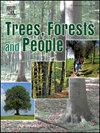Growth of young Melia azedarach trees in abandoned farmlands as planting sites in western Japan
IF 2.7
Q1 FORESTRY
引用次数: 0
Abstract
Melia azedarach is a fast-growing broad-leaved deciduous species native to Japan, and in recent years it has been regarded as a promising silvicultural tree species. The objective of this study was to clarify the factors controlling the growth of the target species in the field. Thirty-three research sites were established in western Japan, where stem diameter at ground level (D0) and at 1.2 m in height (D) and tree height (H) were measured every year, to compare the annual growth rates of individual trees. The stand age ranged from 1 to 8 years at the end of 2021. The mortality rate of each study site in 3 years after planting was higher when the mean temperature in the coldest month, January, was low. When this temperature is below 0 °C, the rate is higher than approximately 0.3. Analysis using general linear mixed models revealed that fertilizer application and the type of planted area (abandoned farmland) positively affected the annual growth rates of D0, D and H (ΔD0, ΔD and ΔH, respectively). The presence of an animal barrier positively affected ΔD0 and ΔH. Temperature in August and precipitation between July and August had a positive and negative effect on ΔD, respectively, whereas temperature in June had positive effect on ΔH. These findings can help to promote efficient silviculture by identifying good planting sites and management plans. Abandoned farmland is considered to be a prospective planting site, compared with forest.
日本西部废弃农田作为种植地点的苦楝幼苗生长
苦楝是一种原产于日本的速生阔叶落叶树种,近年来被认为是一种很有发展前途的造林树种。本研究的目的是澄清控制目标物种在野外生长的因素。在日本西部建立了33个研究点,每年测量地面(D0)、1.2 m高(D)和树高(H)的茎粗,比较单株树木的年生长率。2021年末林龄为1 ~ 8年。各试验点种植后3年的死亡率在最冷月份(1月)平均气温较低时较高。当该温度低于0℃时,速率约高于0.3。利用一般线性混合模型分析发现,施肥和种植面积类型(废弃农田)对D0、D和H的年增长率分别有正向影响(ΔD0、ΔD和ΔH)。动物屏障的存在对ΔD0和ΔH有积极影响。8月气温和7 - 8月降水分别对ΔD有正影响和负影响,6月气温对ΔH有正影响。这些发现有助于通过确定良好的种植地点和管理计划来促进有效的造林。与森林相比,废弃农田被认为是一个有前景的种植地点。
本文章由计算机程序翻译,如有差异,请以英文原文为准。
求助全文
约1分钟内获得全文
求助全文
来源期刊

Trees, Forests and People
Economics, Econometrics and Finance-Economics, Econometrics and Finance (miscellaneous)
CiteScore
4.30
自引率
7.40%
发文量
172
审稿时长
56 days
 求助内容:
求助内容: 应助结果提醒方式:
应助结果提醒方式:


